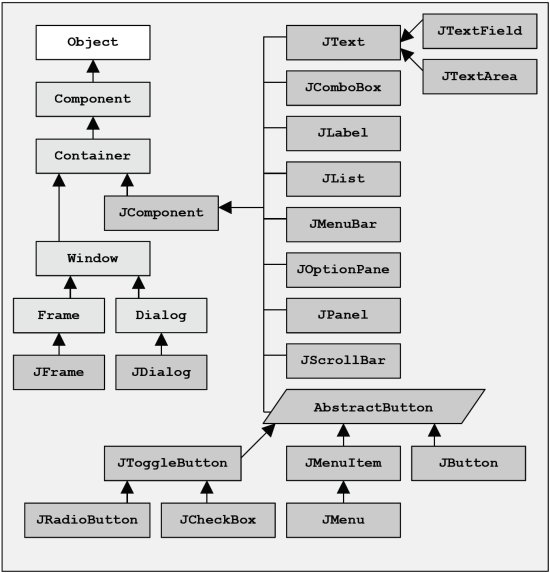
| Home : Course Map : Chapter 6 : Java : |
|
Swing
|
| JavaTech |
| Course Map |
| Chapter 6 |
| About
JavaTech Codes List Exercises Feedback References Resources Tips Topic Index Course Guide What's New |
|
As discussed in the previous AWT section, to provide a more powerful graphical user interface Sun and collaborators developed a set of lightweight component classes under the name Swing that initally ran under Java 1.1 as an optional set of packages and then with Java 1.2 became a part of the standard Java set of classes.
Swing brought a huge improvement in the GUI with new capabilities that ranged from buttons with user selected icons to checkboxes to tables with multiple columns and rows. The Look & Feel, that is, the color scheme and design, of the components could also be customized. See Sun's Visual Index to the Swing Components for a look at the great variety of components available. Swing and came as part of the Java Foundation Classes (JFC) set of packages that also include :
Swing Class Hierarchy The Swing classes build upon the lower level classes of the original AWT (java.awt) graphics packages. As the diagram shows below, the Swing user interface components, which always begin with the letter "J", extend from the Container and Component classes.
The JComponent subclasses are lightweight (see AWT page), so they essentially run within a single heavyweight high level component, such as JFrame and JDialog, and draw and re-draw themselves completely within Java, no native code peer components involved. Combined with the event handling process described in Chapter 7: Java, Swing components provide very flexible and elaborate GUI tools. One can also develop custom components in a straight forward manner by extended either JComponent or one of its subclass components. It is now generally recommended that everyone switch their Java user interface design from AWT to Swing for all serious program development for PC and equivalent platforms. Drawbacks to Swing However, there are some practical drawbacks :
Note: In situations where these drawbacks
prevent the implementation of Swing based GUI, such as when developing
programs for small platforms, it can be necessary to remain within
the older AWT framework. See the Chapter
6: Supplements section for a brief overview creating user interfaces
purely with the standard AWT components. We will cover a number of aspects of Swing in this and later chapters. However, Swing includes an enormous number of classes and so we can only touch on a fraction of their capabilities. One popular reference for Swing prorgamming, Graphic Java 2: Mastering the JFC, requires more than 1600 pages to give in depth descriptions of all the Swing classes. To supplement the materials here, we recommend the on line Swing Tutorial at java.sun.com. References and Web Resources
Latest update: Nov. 3, 2006 |
|
Tech |
|
Physics |
